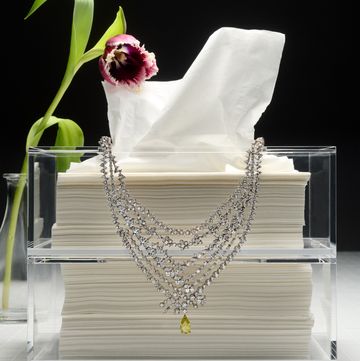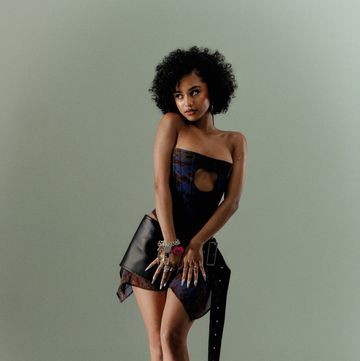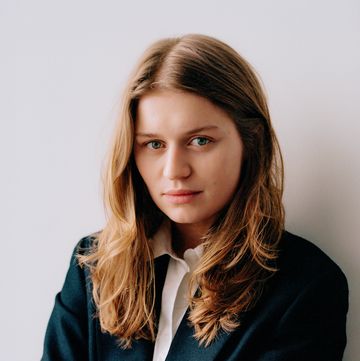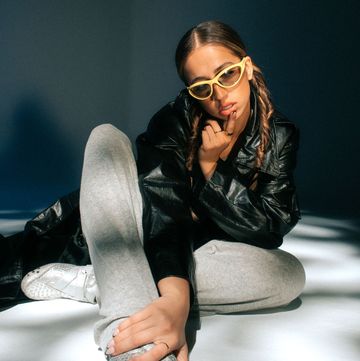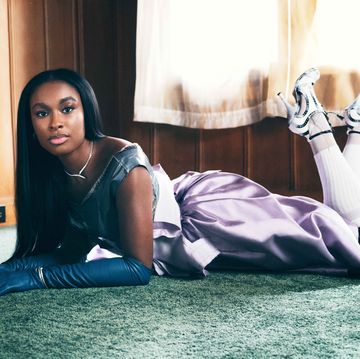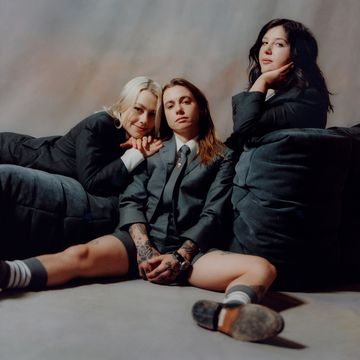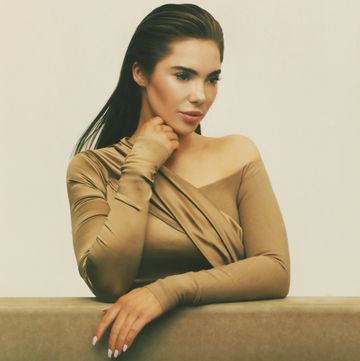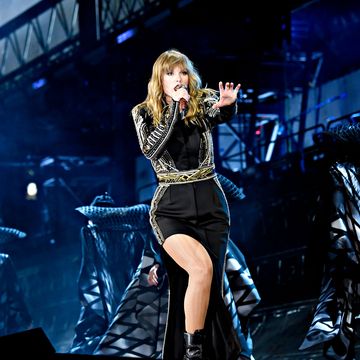When Manfred Thierry Mugler enters a room, the atmosphere shifts. Not only because, seam-burstingly bemuscled and mischievously grinning, he’s impossible to miss, but because he’s a walking icon—a man whose impact on the clothes we wear, and the way we smell, cannot be overstated. The French designer (he now prefers to go by Manfred) founded his eponymous label in 1974 and was a fashion-world superstar throughout the ’80s and ’90s: The extreme shoulders and wasp waists of his outlandish, intricately crafted creations reshaped the female silhouette. He was the first—pre-McQueen, pre–Victoria’s Secret—to inject spectacle and fantasy into his runway shows, supe-studded extravaganzas at which the likes of Naomi, Linda, and Claudia ruled the catwalk in diamanté bustiers and black vinyl, insect-inspired suits. He was also a pioneer in image- and myth-making, trailblazing the practice of transporting models to far-flung locations for lavish, visually striking campaign shoots. Since stepping away from the fashion side of his label in 2003, Mugler has proven to be a creative polymath: conceptualizing characters and designing costumes for Cirque du Soleil; masterminding the Mugler Follies cabaret in Paris; serving as artistic consultant for Beyoncé’s 2009 “I Am…” tour; and directing a massive, extra-terrestrial-themed modern ballet, The Wyld—Not of This World, which debuted in 2014 and ran for 500 performances over two years in the world’s largest theater in Berlin. “What a life!” he says.
And a fragrant one at that. The debut eau from Thierry Mugler Parfums, Angel, was a game changer when it hit counters in 1992: Cutting against the taste of the time for minimal scents, it was a patchouli-drenched, cotton candy–sweet juggernaut that created an entirely new olfactory genre, dubbed “gourmand.” Twenty-five years later, it remains one of the best- selling perfumes of all time. Mugler’s second blockbuster scent, Alien, a radiant burst of jasmine and amber, landed in 2005 and will soon be joined by his latest offering, Aura. Out this February, Aura delivers a lush dose of tiger liana—a plant used in Chinese medicine that’s redolent of the green humidity of a jungle—housed in an emerald, heart-shaped flacon. “It’s a talisman,” says the deeply superstitious Mugler. “Green is the color of the spirit, and it’s the color of concentration. It’s the color of the heart chakra.” He holds the bottle up to the light so it flashes this way and that. “There’s magic in it.”
You started out as a ballet dancer. What stayed with you from that experience?
Thierry Mugler: The idea that through discipline and hard work, you can develop the ability to be in a different dimension within seconds. You can be vomiting, you can detest who you are, detest the world, detest every single thing, and the next moment you are in the light and you glow. You forget everything, and you are just flying. When you’re onstage, you are someone else. Beyoncé is very conscious of this. She said to me, “I’m another person when I’m onstage.” And I said, “Oh yes, you are! You are an animal when you are onstage. You are a stage animal.”
When you reflect on your fashion career, what are you most proud of?
The house of Mugler was a miracle, because we did it without much money. I built a global brand, and we did things that inspired so many people. I’m proud to have helped some amazing people express themselves in new ways. What I appreciate most in the world is to have met and befriended incredible geniuses, like David Bowie and Cyd Charisse and Celia Cruz, who was the goddess of salsa. I saw people kneeling on the streets for her. Which they did for me in Japan. That was really embarrassing.
Do you still see your impact?
Yes, and I’m very proud of—what can I call it?—the science that we put into fashion. That special body-conscious cut that influenced the whole fashion world. Also, the idea of mixing arts on anything—on shoes, on objects, on accessories—this still inspires people.
The fashion business has changed a lot over the years. What do you think of it now?
I think they need me badly. [Laughs] I think now it’s the money who tells the artist what to do—it’s not the artist who tells the money what to do. And things move very fast, which is hard, because sometimes you need more time to be creative. I guess no one has a loud mouth like I did. They don’t dare to scream loudly what they think. But you can’t take fashion too seriously. The whole thing is about giving the woman who wears your clothes some power, some fun, some service. It’s great to make it as art. But first, it’s a service for someone.
Why did you stop designing for the house?
Fashion is beautiful, 3-D art on a human being. But it wasn’t enough, which is why I went on to create in other ways. For me, it wasn’t the right tool anymore. But perfume still interests me.
It has a lot in common with fashion. You wear it to become a different version of yourself.
Yes, exactly. And the fact that perfume is so close to emotion, that’s why I really love it. It’s such a good connection between people. When you fall in love with somebody, smell is very important. It could be your memory of the person—it’s touching. And it’s also playful, because sometimes you choose a different perfume every day depending on your mood. I like to help with that. I like to give a little joy to people.
Aura is quite distinctive.
It’s charged. Zzz! A charge of passion, a charge of love, a charge of work. I had this idea of paying homage to instinct, to our animal nature, to what we all have in common. And trying somehow to top the iconic Angel.
Which is quite a thing to top—even just the bottle.
The idea was to find another symbol that could speak to everyone, like the Angel star. It was hard to find another. But I thought of the heart, and the idea of using the letter m like magic. And m pronounced in French is aime, meaning “love.”
Did you know how you wanted it to smell from the beginning?
The brief was “mystical and animalistic.” I wanted something that could be a classic, but with a big twist. This is an oriental chypre, but I also wanted something virginal in it. That’s why we have orange blossom, which is the virginal note.
With Angel, you sought to evoke the cotton-candy smell of a carnival, because you felt it was universal. Is there something like that in Aura?
Yes, the tiger liana plant, because it smells like fresh-cut grass. I think, for people, that smell is related to happiness, summer, running in fields, innocence. But we also have rhubarb, which is a very strange note. You have this balance. The idea is to keep a link to all people of every race, every origin. And also recognize who and what we are. We’re just beautiful animals, aren’t we?
Do you expect another big hit?
Fragrance is on one side a huge business, and on another side something so fragile. You can market it as much as you want, but you never know if it’s going to be a success. It’s very human, and it touches so many intimate aspects of emotion. It’s really a language, and it speaks to people or it doesn’t. There’s something magical about that. And I love the riskiness of it.
What’s your next project?
There will be new shows and a lot of other things. I’m designing a dream hotel, a resort, with entertainment [Mugler announced his partnership with the design and architecture consultancy firm +Cassia earlier this year]. It will be a whole universe. I can’t tell you where it will be yet, but let’s just say the first one is in a sort of paradise. It’s mostly about the concept: how to create a place to help people dream and focus on themselves and rediscover themselves. It’s a very sensational and sensuous environment, but it’s also simple. I think simplicity is something that we miss more and more, and with everything going on in the world, we need it.
I’m also working on a major Mugler exhibition with the Musée des Beaux-Arts in Montreal. You’re the first to know. It won’t be a retrospective, because I think the archives speak for themselves. But I’ll tell you a secret: The last room will be called Couture Future. And there will be clothes made especially for the exhibition. Very special outfits. It never ends, you see. I work hard today for a better tomorrow.
So the future, rather than the past, is your greatest inspiration?
Exactly. Our ability to be surprised is infinite. So let’s keep going.
From left: Model photographed by Mugler in Volgograd (1986); “La Chimere” couture collection (1997); Linda Evangelista in George Michael’s “Too Funky” video, directed by Mugler (1992); the first Angel ad (1992); Iman in the Sahara (1985)
Joy Division
The luminous AURA MUGLER (1), which Mugler calls “a message of hope,” housed in a faceted flacon he designed himself. His skin-care must: CLARINS Double Serum (2), laced with inflammation-fighting turmeric. Mugler, who says that “stretching, yoga, and working out every day” provide him with inner zen, swears by these wellness tips (3): “A drop of organic lemon in each eye when one is tired,” he says, “is the best eye drop ever.” And, from head to toe: “A very rare argan oil that my Moroccan cook brings me back from the mountains of Morocco near Sidi Ifni—a local craft product.”
This article originally appears in the November 2017 issue of ELLE.







